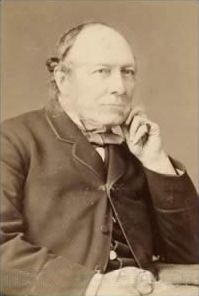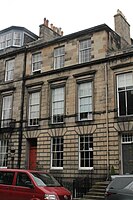Thomas Stevenson
Thomas Stevenson | |
|---|---|
 Stevenson in 1880 | |
| Born | 22 July 1818 Edinburgh, Scotland |
| Died | 8 May 1887 (aged 68) Edinburgh, Scotland |
| Occupation | Lighthouse engineer |
| Employer | Northern Lighthouse Board |
| Spouse(s) | Maggie Balfour (m. 1848) |
| Children | Robert Louis Stevenson |
| Parent(s) | Robert Stevenson (father) Jean Smith (mother) |
| Relatives | David Stevenson (brother) Alan Stevenson (brother) |
| Signature | |
Thomas Stevenson PRSE MInstCE FRSSA FSAScot (22 July 1818 – 8 May 1887) was a pioneering Scottish civil engineer, lighthouse designer and meteorologist, who designed over thirty lighthouses in and around Scotland, as well as the Stevenson screen used in meteorology. His designs, celebrated as ground breaking, ushered in a new era of lighthouse creation.
He served as president of the Royal Scottish Society of Arts (1859–60), as president of the Royal Society of Edinburgh (1884–86), and was a co-founder of the Scottish Meteorological Society.[1]
Life[]
He was born at 2 Baxters Place[2] in Edinburgh, on 22 July 1818, the youngest son of engineer Robert Stevenson, and his wife (and step-sister) Jean Smith. He was educated at the Royal High School in Edinburgh.
Thomas Stevenson was a devout and regular attendee at St. Stephen's Church in Stockbridge, at the north end of St Vincent Street, Edinburgh.
He lived with his family at Baxters Place until he got married in 1848. He then got a house at 8 Howard Place.[3] By 1855 he moved to 1 Inverleith Terrace.[4]
From at least 1860 he lived at 17 Heriot Row, a large Georgian terraced townhouse in Edinburgh's New Town.[5]
In 1869, as a successful experiment into using the newly invented electric light for lighthouses, Stevenson had an underwater cable installed from the eastern part of Granton Harbour, and a light on the end of the Trinity Chain Pier was controlled from half a mile away by an operator on the harbour.[6][7]
He examined wind and wave effects, and his analysis[8] is the first quantitative discussion of wave height as a (square root) function of fetch. His paper[9] is one of the first quantitative studies of wind speeds in the planetary boundary layer. Motivated by practical applications, these are fundamental contributions. He designed the Stevenson screen as a shelter to shield meteorological instruments, and this has been widely adopted.
He died at 17 Heriot Row in Edinburgh on 8 May 1887 and is buried in the Stevenson family vault in New Calton Cemetery. The vault lies midway along the eastern wall.
Family[]
He was brother of the lighthouse engineers Alan and David Stevenson, between 1854 and 1886 he designed many lighthouses, with his brother David, and then with David's son David Alan Stevenson.
He married Margaret Isabella "Maggie" Balfour in 1848, daughter of Rev Lewis Balfour. Their son was the writer Robert Louis Stevenson, who caused him much disappointment by failing to follow the engineering interests of his family.[10]
His wife's younger brother, James Melville Balfour (i.e. his brother-in-law), trained under D. & T. Stevenson and then emigrated to New Zealand, where he was first the marine engineer for Otago Province before he appointed Colonial Marine Engineer.[10][11]
Lighthouses designed by Thomas Stevenson[]
- (1854)
- Out Skerries (1854)
- Muckle Flugga (1854)
- Davaar (1854)
- Ushenish (1857)
- South Rona (1857)
- Kyleakin (1857)
- Ornsay (1857)
- Sound of Mull (1857)
- Cantick Head (1858)
- Bressay (1858)
- Ruvaal (1859)
- Corran Point (1860)
- Fladda (1860)
- (1861)
- St Abb's Head (1862)
- Butt of Lewis (1862)
- Holborn Head (1862)
- Monach Islands (1864)
- (1865)
- Auskerry (1866)
- (1869)
- Scurdie Ness (1870)
- (1870)
- Dubh Artach (1872)
- Turnberry Point (1873)
- Chicken Rock (1875)
- Lindisfarne (1877, 1880)
- Fidra (1885)
- (1886)
- Ailsa Craig Lighthouse (1886)
Gallery[]

Townhouse at 17 Heriot Row, Edinburgh

Condensing light. Lighthouse optic, designed by Thomas Stevenson. Chance Brothers and Company, Birmingham, 1866. National Museum of Scotland, Edinburgh

Thomas Stevenson by Sir George Reid, 1878
See also[]
- Richard Henry Brunton, "father of Japanese lighthouses"
- John Richardson Wigham, Irish inventor and lighthouse engineer
References[]
- ^ Waterston, Charles D; Macmillan Shearer, A (July 2006). Former Fellows of the Royal Society of Edinburgh 1783-2002: Biographical Index (PDF). II. Edinburgh: The Royal Society of Edinburgh. ISBN 978-0-902198-84-5. Archived from the original (PDF) on 4 October 2006. Retrieved 31 December 2010.
- ^ Edinburgh Post Office Directory 1818
- ^ Edinburgh Post Office Directory 1850
- ^ Edinburgh Post Office directory 1855
- ^ Edinburgh Post Office Directory 1860
- ^ The Nautical Magazine and Naval Chronicle for 1869. Cambridge Library Collection. 28 March 2013. pp. 614–615.
- ^ Stevenson, Thomas (9 April 2009). Lighthouse Construction and Illumination. BiblioBazaar. pp. 165–166. ISBN 978-1103900954.
- ^ Stevenson, T. The Design and Construction of Harbors: A Treatise on Maritime Engineering, seconded. Adam and Charles Black, Edinburgh
- ^ Stevenson, T. (1880) Report on Simultaneous Observations of the Force of Wind at Different Heights above the Ground, Journal of the Scottish Meteorological Society, LI-LIV, pp. 103–107
- ^ Jump up to: a b "The Late Mr Balfour". The Star (503). 29 December 1869. p. 3. Retrieved 4 January 2015.
- ^ Beaglehole, Helen (9 July 2013). "Lighthouses - A national system". Te Ara: The Encyclopedia of New Zealand. Retrieved 4 January 2015.
External links[]
- 1818 births
- 1887 deaths
- 19th-century Scottish people
- Lighthouse builders
- Presidents of the Royal Society of Edinburgh
- People educated at the Royal High School, Edinburgh
- Alumni of the University of Edinburgh
- Scottish civil engineers
- Scottish inventors
- Burials at the New Calton Burial Ground
- Scottish meteorologists
- Scottish antiquarians
- People from Edinburgh



